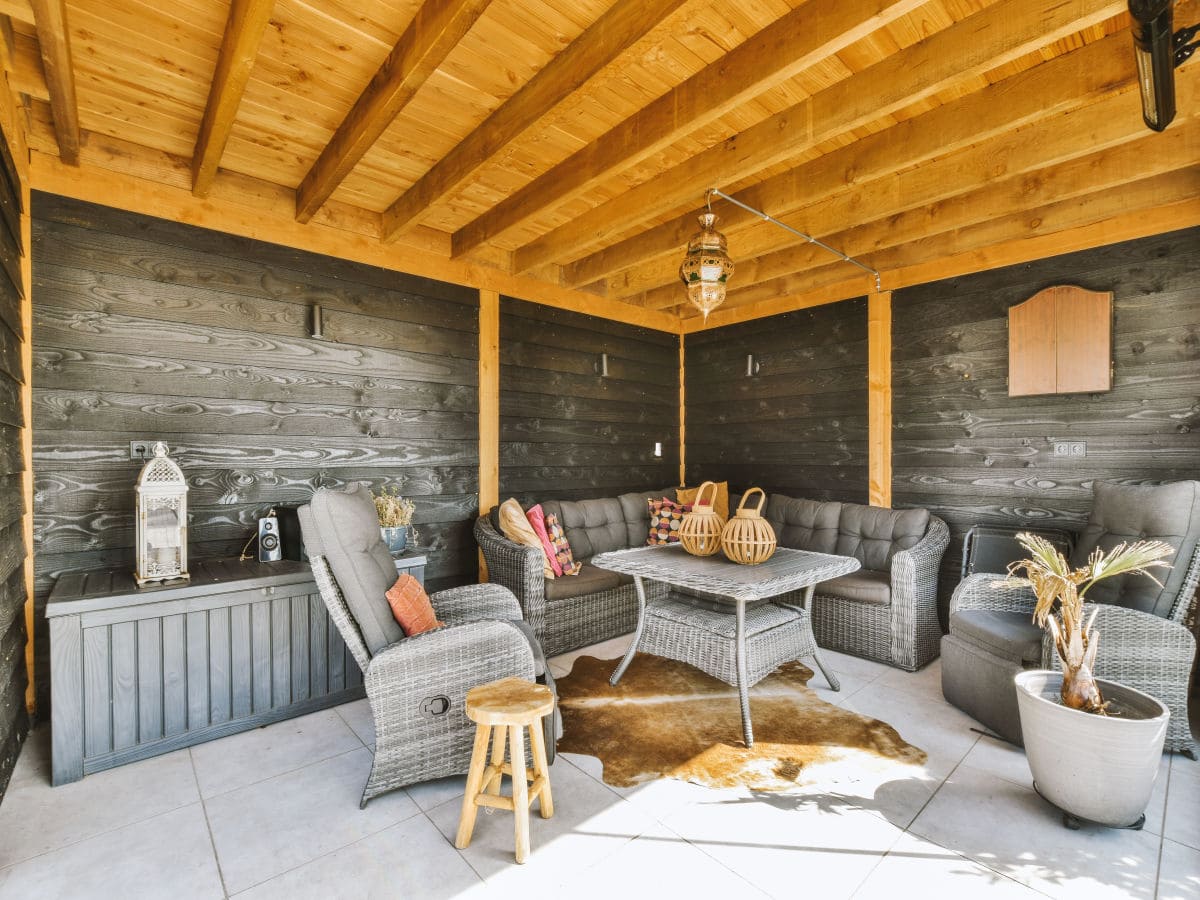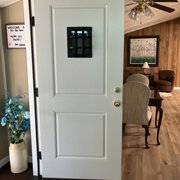Outdoor spaces transform when a patio cover is added, elevating functionality and aesthetic appeal. Patio covers create vital weather protection and extend living space, offering an aesthetic boost to various landscape styles, from traditional to modern.
Picture a typical backyard, open to the elements and limited in its usability during harsh weather conditions. Now, envision the same space enhanced by a strategically placed patio cover. This single addition morphs a sun-drenched, occasionally barren area into a welcoming outdoor haven, versatile enough to complement any landscape style.
The Basics of Patio Covers
Patio covers are structures designed to offer shade and protection to outdoor spaces, often attached to the home but sometimes freestanding. They vary in design, size, and functionality, serving as both practical and decorative additions to a property.
Materials Commonly Used
Common materials for patio covers include wood, metal, and fabric. Wood is often favored for its natural aesthetic but requires regular maintenance. Metal options like aluminum are durable and low-maintenance, whereas fabric choices like canvas offer flexibility but may lack longevity.
Benefits of Patio Covers
- Weather Protection
One of the primary benefits of installing a patio cover is weather protection. Whether shielding from harsh sun rays, providing refuge during a downpour, or offering a buffer against wind, a patio cover makes the outdoor space more versatile and comfortable throughout the year.
- Extended Living Space
A patio cover effectively increases your living area by making the outdoor space more functional. With added protection and comfort, the patio becomes an extension of the indoor living space, perfect for dining, relaxation, or entertaining.
- Aesthetic Appeal
Beyond the practical aspects, patio covers bring a visual upgrade to your backyard. They can be customized to match the architectural style of your home and landscape, thus serving as an aesthetically pleasing focal point.
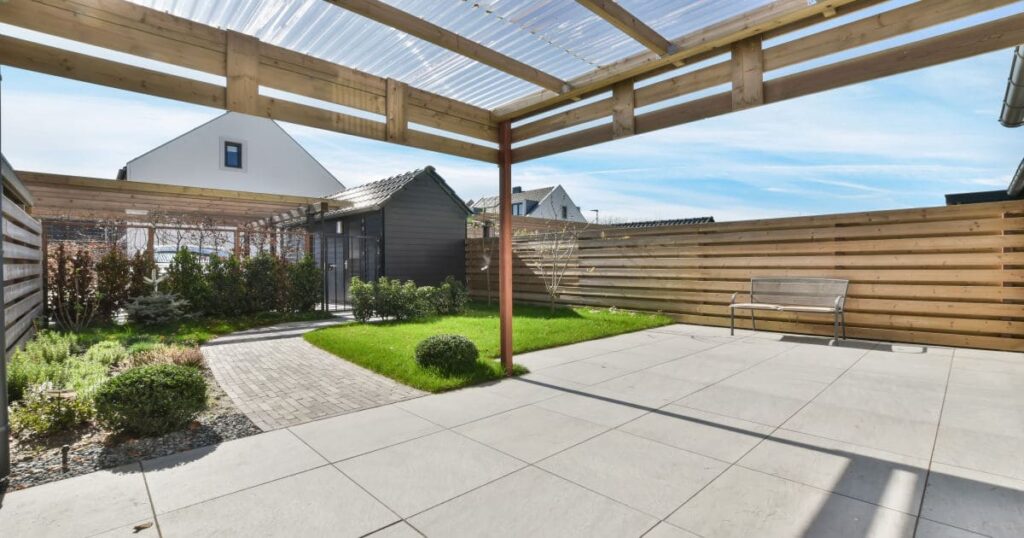
Types of Patio Covers
Pergolas
Pergolas are open-structure patio covers usually made of wood or metal, featuring a grid-like roof that allows some sunlight to filter through. They are particularly popular in gardens and large patios, which can serve as a decorative element and a functional space for hanging plants or lights.
Awnings
Awnings are attached directly to the home and extend outwards to cover a patio area. They are often made from fabric but can also be constructed from aluminum. Retractable options offer flexibility, allowing homeowners to extend or retract the awning based on the weather conditions.
Gazebos
Gazebos are freestanding, often octagonal or round, structures with a solid roof and open or semi-open sides. They provide full shade and can be equipped with additional features like screens or curtains for added privacy and bug protection. Gazebos are versatile, fitting well into both formal and casual landscape styles.
Shade Sails
Shade sails are modern, minimalist patio covers made of tensioned fabric anchored to poles or attached to buildings. They are known for their sculptural beauty and are often used in contemporary landscape designs. Although not as robust as other types, shade sails offer a unique aesthetic and customizable shape and size.
Landscape Styles and Patio Covers
Traditional Landscapes
In traditional landscape styles, patio covers often serve as a natural extension of the home, mirroring the architectural elements and materials that define the space. Wood pergolas stained to match the home’s hues or gazebos with design elements that echo the home’s architectural details are commonly used. These structures may also incorporate classic features like ornate latticework, scroll designs, or chandeliers to accentuate the traditional vibe.
Integrating a patio cover in a traditional landscape not only fulfills a functional role but also contributes to the overall cohesive and timeless look. A well-designed patio cover can even become the centerpiece of the outdoor space, where other traditional design elements like flower beds, stone pathways, and water features can be arranged.
Modern Landscapes
In modern landscapes, the emphasis is on sleek lines, minimalistic design, and functional spaces. Patio covers like retractable awnings or metal pergolas with clean geometric shapes fit seamlessly into this design philosophy. Materials like aluminum or stainless steel are often favored for durability and contemporary look. Fabric choices for awnings or shade sails might lean towards neutral or monochromatic colors to maintain a streamlined appearance.
Additionally, modern patio covers can incorporate technology for added convenience and functionality. For instance, retractable awnings might come with remote controls or sensors that detect weather conditions, automatically extending or retracting based on the situation.
Integrating a patio cover in a modern landscape styles serves not just as a practical addition but also as a design statement. The clean lines and high-tech features complement other elements in modern outdoor spaces, such as linear planters, modular furniture, and LED lighting.
Tropical Landscapes
In a tropical landscape styles, the focus is often on creating a lush, exotic atmosphere filled with vibrant plants, water features, and colorful accents. Patio covers in these settings often take inspiration from the island or beachside structures. Think bamboo or thatch-roofed gazebos or fabric shade sails in vibrant hues that echo the surrounding flora.
Patio covers can be integrated to not just provide shade but also to serve as a structure for tropical vines or hanging plants, further enhancing the jungle-like feel. The material and color choices for the patio cover can also complement other elements commonly found in tropical landscapes, such as tiki torches, rattan furniture, or stone pathways.
The patio cover becomes more than just a functional element; it’s a part of the overall tropical tapestry, contributing to the atmosphere of a private oasis. In this way, the patio cover can be both a focal point and a unifying element, tying together various components of the tropical setting.
Desert Landscapes
In desert landscape styles, the design emphasizes hardy, drought-resistant plants, gravel or stone grounds, and a palette that reflects the natural surroundings. Patio covers in these settings often aim to offer respite from the intense sun while blending seamlessly with the rugged environment. Material choices may lean toward hard-wearing and heat-resistant options like metal or treated wood, designed to withstand harsh climatic conditions.
Design-wise, a patio cover in a desert landscape might incorporate elements that mirror the natural surroundings. For example, a pergola could be built using reclaimed wood or weathered metal to harmonize with the landscape’s rustic aesthetic. Alternatively, a shade sail in earth tones can provide necessary shade while minimizing visual disruption to the setting.
In desert landscape styles, the patio cover is not merely an add-on but an integrated part of the overall design. It not only provides much-needed shade but also contributes to maintaining the visual flow and thematic cohesion of the outdoor space.
Cottagecore Landscapes
Cottagecore landscapes embrace a pastoral and nostalgic aesthetic, featuring wildflowers, picket fences, and vintage or rustic furniture. In such settings, patio covers often serve as whimsical or cozy nooks that enhance the storybook quality of the space. Wooden pergolas laden with climbing roses or wisteria are a common choice, adding to the garden’s romantic and rustic atmosphere.
Fabric options for patio covers might include floral or gingham patterns that align with the cottagecore theme. Even awnings or shade sails can be adapted to fit this style, especially from materials that evoke a handcrafted or vintage look.
The patio cover in a cottagecore landscape is more than just a practical structure; it’s a key player in creating a setting that feels both nostalgic and idyllic. Whether serving as a backdrop for afternoon tea or as a reading nook surrounded by the sounds and sights of nature, the patio cover becomes a living part of the landscape’s fairytale charm.
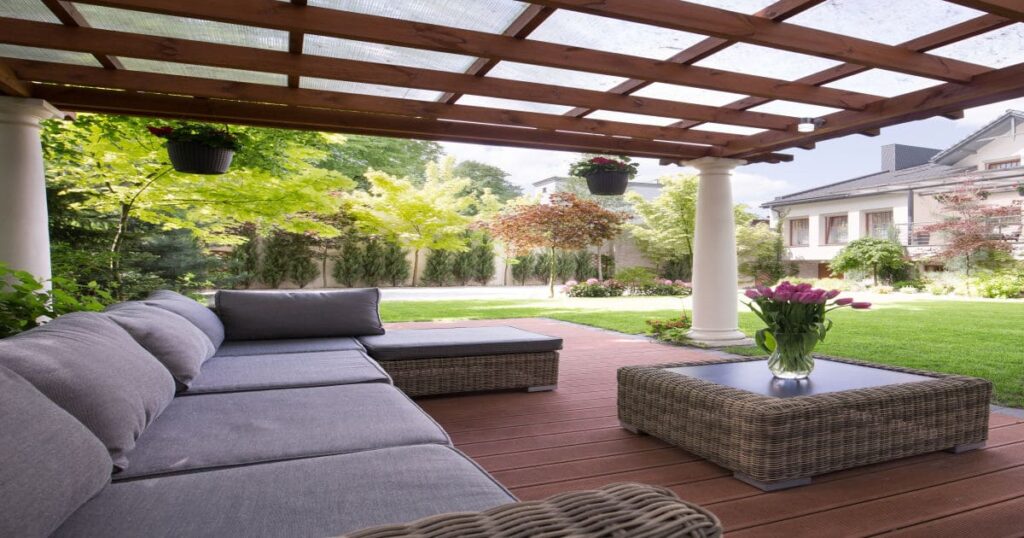
Design Tips for Integrating Patio Covers
Material Matching
When adding a patio cover, choosing a material that complements existing elements can make the outdoor space more cohesive. For instance, if your deck is made of redwood, consider a redwood pergola to create a seamless transition. Similarly, if you have a lot of metal accents like outdoor light fixtures or furniture, an aluminum or steel patio cover could be a fitting addition.
Plant Selection
The plants around your patio cover can significantly impact its aesthetic and function. In tropical or cottagecore landscapes, consider climbing plants like wisteria, roses, or honeysuckle to create a living canopy. For desert landscapes, potted cacti or succulents placed around a metal pergola can evoke the natural environment. Think about not only how the plants will look but also how they’ll interact with the structure. Some plants might provide additional shade, while others could be purely decorative.
Color Coordination
The color of your patio cover should align with the palette of your outdoor space and home exterior for a unified look. Neutral colors like white, beige, or gray often work well in modern landscapes, while more vibrant or natural tones can be more fitting for tropical or traditional settings. Remember that the color you choose will interact with the natural light and could influence the atmosphere of the space. For example, a darker color might make the space feel smaller but cozier, while a lighter shade could add a more airy and open feel.
Costs and Budgeting
Cost Factors
The financial aspect of integrating a patio cover into your landscape involves multiple variables. Material costs are often the most significant, with options like aluminum and high-quality wood usually at the higher end of the spectrum. Labor costs can also be substantial, especially for more complex designs or if the patio cover needs to be custom-built. Additional factors like the size of the patio cover, any specialized technology or features, and even local building permits can also influence the overall expense.
Budgeting Tips
Planning is key to staying within budget while achieving your patio cover aspirations. Here are some practical tips:
Prioritize Needs Over Wants: Make a list of must-haves and nice-to-haves. Perhaps a simple shade sail will suffice over a more elaborate pergola if your primary need is sun protection.
Get Multiple Quotes: It’s wise to obtain estimates from multiple contractors to gauge the market rate for your project. This can also provide leverage in negotiating prices.
Phase the Project: If budget is a concern, consider phasing the project over a longer period. Start with a basic structure and add features or enhancements later when finances allow.
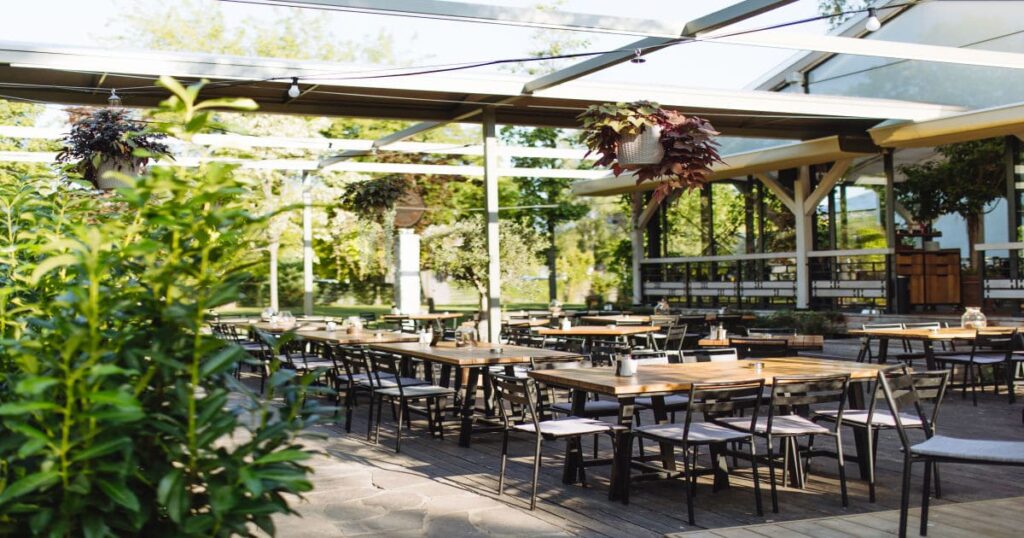
Maintenance and Upkeep
Cleaning Tips
Regular cleaning can help maintain the appearance and integrity of your patio cover. For wood structures, a simple soap-and-water mixture often suffices for surface cleaning. For metal or vinyl, specialized cleaners are available that remove dirt and grime without affecting the material’s finish. Always test a small area first to ensure the cleaner matches your patio cover material.
Seasonal Care
Each season brings its own set of challenges for patio cover maintenance:
Spring: This is the time for thorough inspections. Check for any winter damage and make necessary repairs. It’s also a good time to reseal or repaint wooden structures.
Summer: High temperatures and intense sunlight can cause materials to fade or warp. Use protective sealants for wood and keep metal structures clean to prevent heat-related deterioration.
Autumn: Clear away leaves and other debris from the roof and gutters of your patio cover to prevent water pooling and eventual rot or corrosion.
Winter: If you live in a snow-prone area, remove heavy snow from the top of your patio cover to prevent structural damage.
Longevity and Replacement
The lifespan of a patio cover largely depends on the material used and how well it’s maintained. If well cared for, wood structures can last over 15 years. Metal and vinyl covers can last even longer with proper upkeep. Signs that replacement is needed could include persistent leaks, visible rot, or severe warping.
A Canopy of Possibilities
Patio covers are more than just functional appendages; they are transformative elements that enrich diverse landscape styles, be it the rustic allure of desert terrains, the nostalgic warmth of cottage-core gardens, or the minimalist elegance of modern spaces. By strategically choosing materials, plants, and colors, you can integrate these structures seamlessly, making them as much a part of your outdoor narrative as the flora and furniture around them. So, don’t hold back—unleash your creativity, experiment with designs, and make that patio cover uniquely yours. After all, the sky—or perhaps, the cover—is the limit.
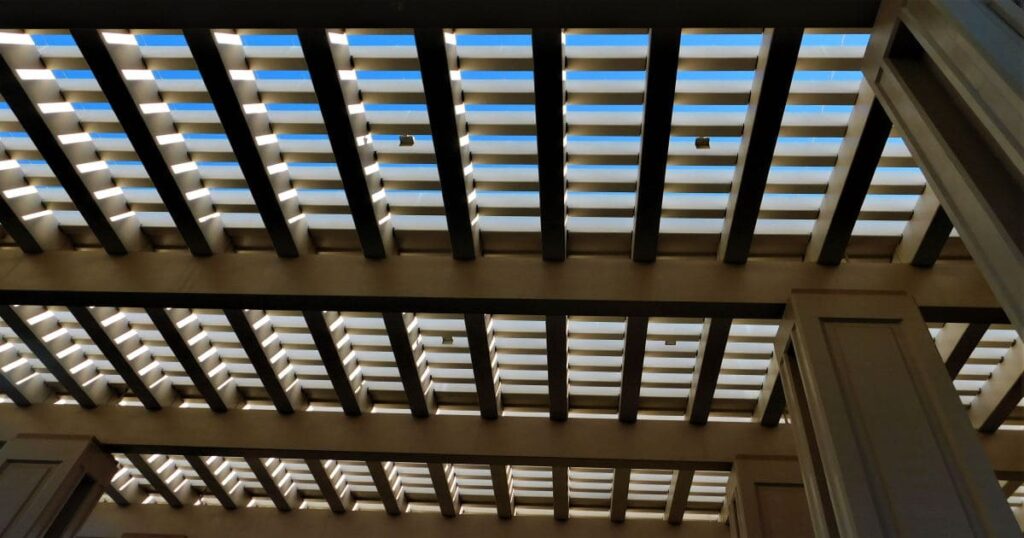
Frequently Asked Questions
Can I Install a Patio Cover Without a Permit?
Permit requirements depend on location and the type of structure you’re installing. It’s advisable to check with your local municipality or homeowners association for specific guidelines.
How Do I Choose the Right Size for My Patio Cover?
The size of your patio cover should align with the available space and your specific needs. Too large could overwhelm your yard, while too small may not provide adequate protection or functionality.
How Do I Protect My Patio Cover From Pests?
Using treated wood can deter termites, while regular cleaning can prevent bird or wasp nests. Some people also use natural or chemical repellents to keep pests at bay.
Can a Patio Cover be Attached to the House?
Yes, many patio covers are designed to be attached to an existing structure. However, this often requires more careful planning and possibly a building permit, as it involves altering your home.
Is it Possible to Install Lighting and Fans on My Patio Cover?
A: Yes, many patio covers can accommodate electrical fixtures like lighting and fans, although this will likely require professional installation to ensure safety and compliance with electrical codes.
What’s the Best Way to Decorate My Patio Cover for Seasonal Events?
Temporary decorations like string lights, fabric drapes, or themed ornaments can add a festive touch. Just make sure any additions are securely fastened and suitable for outdoor conditions.

